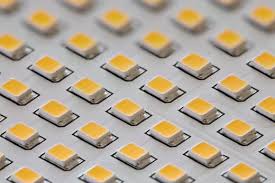What is Surface-Mounted Device (SMD) LEDs? and Their Advantages as Microscope Light Sources
Surface-mounted device (SMD) LEDs have revolutionized the lighting industry with their compact design, energy efficiency, and versatility. These LEDs are mounted directly onto the surface of printed circuit boards (PCBs), eliminating the need for through-hole components. This design allows for higher-density mounting, making SMD LEDs ideal for applications where space is limited and precision is critical. In recent years, SMD LEDs have gained significant traction as light sources for microscopes, offering numerous advantages over traditional lighting solutions.
What Are SMD LEDs?
SMD LEDs are an LED package that utilizes surface-mount technology (SMT) for assembly. Unlike traditional through-hole LEDs, SMD LEDs are soldered directly onto the surface of PCBs, enabling smaller and more compact designs. They come in various sizes, such as 3528, 5050, and 2835, with each variant offering different levels of brightness, color temperature, and power efficiency. SMD LEDs are widely used in applications ranging from consumer electronics to automotive lighting and, more recently, scientific instruments like microscopes.
Advantages of SMD LEDs as Microscope Light Sources - LED-77( Brand: AMZINST)
1. Compact and Lightweight Design
SMD LEDs are significantly smaller and lighter than traditional light sources, such as halogen or incandescent bulbs. This compactness allows for seamless integration into microscope systems without adding bulk or weight, making them ideal for portable and handheld microscopes.
2. Energy Efficiency
SMD LEDs consume far less power compared to conventional light sources. This energy efficiency not only reduces operating costs but also minimizes heat generation, which is crucial for maintaining sample integrity during prolonged microscopy sessions.
3. High Brightness and Uniform Illumination
SMD LEDs provide exceptional brightness and uniform light distribution, ensuring consistent illumination across the entire field of view. This is particularly important for high-resolution imaging and detailed sample analysis.
4. Adjustable Color Temperature
SMD LEDs can be engineered to emit light at specific color temperatures, ranging from warm white to cool white. This adjustability allows researchers to optimize lighting conditions for different types of samples, enhancing contrast and clarity.
5. Long Lifespan
With an average lifespan of 50,000 to 100,000 hours, SMD LEDs far outlast traditional light sources. This longevity reduces the need for frequent replacements, ensuring uninterrupted microscopy workflows.
6. Low Heat Emission
Unlike halogen bulbs, which can generate significant heat, SMD LEDs produce minimal thermal output. This feature is particularly beneficial for observing heat-sensitive biological samples, as it prevents damage or degradation.
7. Environmental Friendliness
SMD LEDs are free from hazardous materials like mercury, making them an eco-friendly choice. Their low power consumption also contributes to a smaller carbon footprint.
8. Customizable Configurations
SMD LEDs can be arranged in arrays or clusters to meet specific lighting requirements. This flexibility allows for tailored illumination solutions that cater to different microscopy techniques, such as brightfield, darkfield, or fluorescence microscopy.
Surface-Mounted Device (SMD) LEDs have emerged as a superior lighting solution for microscopes, offering a combination of compact design, energy efficiency, and high performance. Their ability to provide bright, uniform, and adjustable illumination makes them an invaluable tool for researchers and scientists. As technology continues to advance, SMD LEDs are poised to become the standard light source for modern microscopy, enabling clearer, more accurate, and more efficient sample analysis.
By adopting SMD LEDs, microscopy systems can achieve enhanced functionality while reducing operational costs and environmental impact—a win-win for both science and sustainability.







